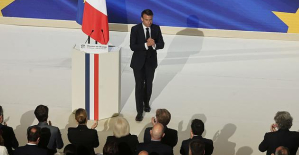The day after the restitution to the descendants of the Saulmanns and those of Harry Fuld junior of two paintings and a sculpture from the 15th century, the Minister of Culture Rima Abdul Malak presented a framework bill on the burning question of Nazi spoliations . It will concern the specific case of works stolen from collectors or Jewish families, then entered into public collections.
During the Occupation, a hundred thousand works of art were stolen by the Germans, mainly from Jews. After the conflict, nearly 60,000 were brought back by the Allies from Germany and Austria, - including part of the Rothschild's fabulous art collection. In the 1950s, for lack of finding the owners, the State sold some of the works repatriated from Germany (those said to be of lesser heritage interest) and kept 2,200 others in French museums (MNR). Between 1954 and 2023, 184 were returned to the descendants of their rightful owners.
With this framework law, the government wants to go further by asking public museums to carry out searches from their collections, in order to identify paintings or objects that would have been spoliated from Jews, between 1933 and until today. today, in France or in other European countries.
Having integrated the national collections, and being considered non-transferable (inalienable), their possible restitutions currently require a heavy procedure of “downgrading”, then a passage before the parliament. In April 2022, the French State thus returned a painting by Chagall, The Father, which entered the national collections in 1988 by donation in payment of the rights of Chagall's estate. After research, it turned out that the painting had been stolen from a luthier, David Cender, in 1940 in Poland, as part of the Nazi anti-Semitic persecutions. before delivering the canvas in person to the descendants, at the Museum of Art and History of Judaism where it was exploded, the State had to pass a law authorizing the transfer.
The bill, which could be presented before the summer, aims to provide a general framework, a method and criteria, in order to avoid doing it on a case-by-case basis.
By definition, we don't know how many works will be affected. The Louvre and the Musée d'Orsay began heavy research on the provenance, trying to sift through all the purchases made from 1933 onwards. Thefts, trafficking and the art market were flourishing during the dark years Nazism, and it's a safe bet that some works were originally stolen (or coerced) from Jews.
For museums, the task is daunting, but the game is worth the effort. "Identifying and finding these cultural assets and returning them to the victims' heirs means doing a work of justice, but also of memory, to allow the descendants of looted Jewish families to find their history," said the Minister of Culture, which speaks of a historic step.

 Hamas-Israel war: US begins construction of pier in Gaza
Hamas-Israel war: US begins construction of pier in Gaza Israel prepares to attack Rafah
Israel prepares to attack Rafah Indifference in European capitals, after Emmanuel Macron's speech at the Sorbonne
Indifference in European capitals, after Emmanuel Macron's speech at the Sorbonne Spain: what is Manos Limpias, the pseudo-union which denounced the wife of Pedro Sánchez?
Spain: what is Manos Limpias, the pseudo-union which denounced the wife of Pedro Sánchez? Spain is the country in the European Union with the most overqualified workers for their jobs
Spain is the country in the European Union with the most overqualified workers for their jobs Parvovirus alert, the “fifth disease” of children which has already caused the death of five babies in 2024
Parvovirus alert, the “fifth disease” of children which has already caused the death of five babies in 2024 Colorectal cancer: what to watch out for in those under 50
Colorectal cancer: what to watch out for in those under 50 H5N1 virus: traces detected in pasteurized milk in the United States
H5N1 virus: traces detected in pasteurized milk in the United States Private clinics announce a strike with “total suspension” of their activities, including emergencies, from June 3 to 5
Private clinics announce a strike with “total suspension” of their activities, including emergencies, from June 3 to 5 The Lagardère group wants to accentuate “synergies” with Vivendi, its new owner
The Lagardère group wants to accentuate “synergies” with Vivendi, its new owner The iconic tennis video game “Top Spin” returns after 13 years of absence
The iconic tennis video game “Top Spin” returns after 13 years of absence Three Stellantis automobile factories shut down due to supplier strike
Three Stellantis automobile factories shut down due to supplier strike A pre-Roman necropolis discovered in Italy during archaeological excavations
A pre-Roman necropolis discovered in Italy during archaeological excavations Searches in Guadeloupe for an investigation into the memorial dedicated to the history of slavery
Searches in Guadeloupe for an investigation into the memorial dedicated to the history of slavery Aya Nakamura in Olympic form a few hours before the Flames ceremony
Aya Nakamura in Olympic form a few hours before the Flames ceremony Psychiatrist Raphaël Gaillard elected to the French Academy
Psychiatrist Raphaël Gaillard elected to the French Academy Skoda Kodiaq 2024: a 'beast' plug-in hybrid SUV
Skoda Kodiaq 2024: a 'beast' plug-in hybrid SUV Tesla launches a new Model Y with 600 km of autonomy at a "more accessible price"
Tesla launches a new Model Y with 600 km of autonomy at a "more accessible price" The 10 best-selling cars in March 2024 in Spain: sales fall due to Easter
The 10 best-selling cars in March 2024 in Spain: sales fall due to Easter A private jet company buys more than 100 flying cars
A private jet company buys more than 100 flying cars This is how housing prices have changed in Spain in the last decade
This is how housing prices have changed in Spain in the last decade The home mortgage firm drops 10% in January and interest soars to 3.46%
The home mortgage firm drops 10% in January and interest soars to 3.46% The jewel of the Rocío de Nagüeles urbanization: a dream villa in Marbella
The jewel of the Rocío de Nagüeles urbanization: a dream villa in Marbella Rental prices grow by 7.3% in February: where does it go up and where does it go down?
Rental prices grow by 7.3% in February: where does it go up and where does it go down? “Deadly Europe”, “economic decline”, immigration… What to remember from Emmanuel Macron’s speech at the Sorbonne
“Deadly Europe”, “economic decline”, immigration… What to remember from Emmanuel Macron’s speech at the Sorbonne Sale of Biogaran: The Republicans write to Emmanuel Macron
Sale of Biogaran: The Republicans write to Emmanuel Macron Europeans: “All those who claim that we don’t need Europe are liars”, criticizes Bayrou
Europeans: “All those who claim that we don’t need Europe are liars”, criticizes Bayrou With the promise of a “real burst of authority”, Gabriel Attal provokes the ire of the opposition
With the promise of a “real burst of authority”, Gabriel Attal provokes the ire of the opposition These French cities that will boycott the World Cup in Qatar
These French cities that will boycott the World Cup in Qatar Judo: Blandine Pont European vice-champion
Judo: Blandine Pont European vice-champion Swimming: World Anti-Doping Agency appoints independent prosecutor in Chinese doping case
Swimming: World Anti-Doping Agency appoints independent prosecutor in Chinese doping case Water polo: everything you need to know about this sport
Water polo: everything you need to know about this sport Judo: Cédric Revol on the 3rd step of the European podium
Judo: Cédric Revol on the 3rd step of the European podium


















